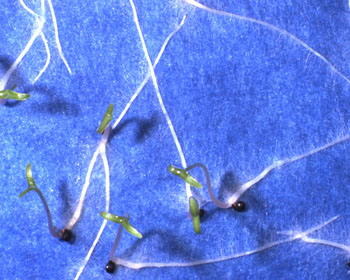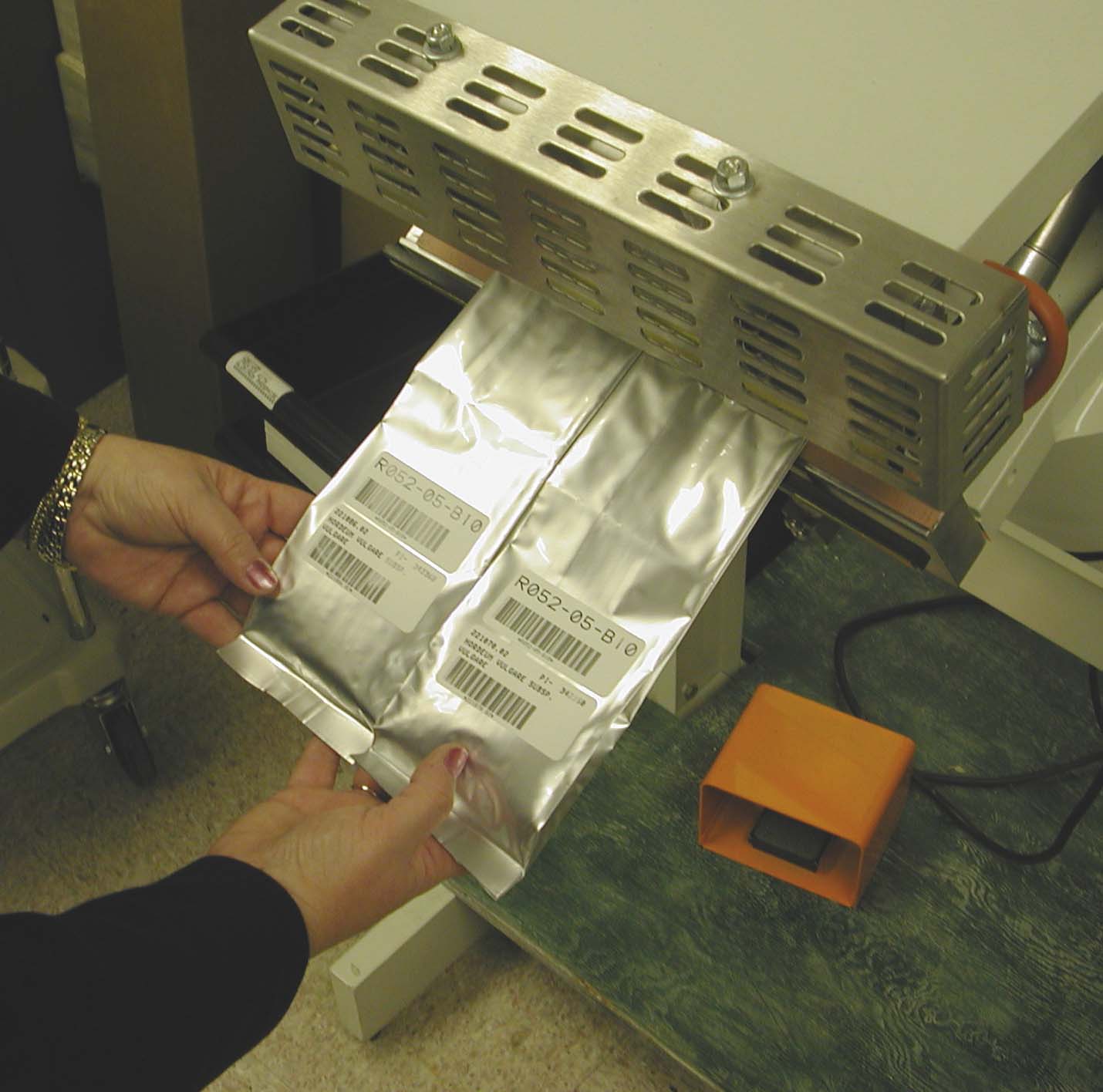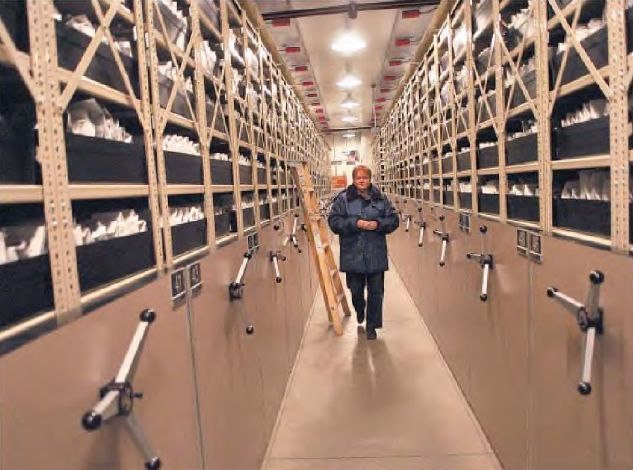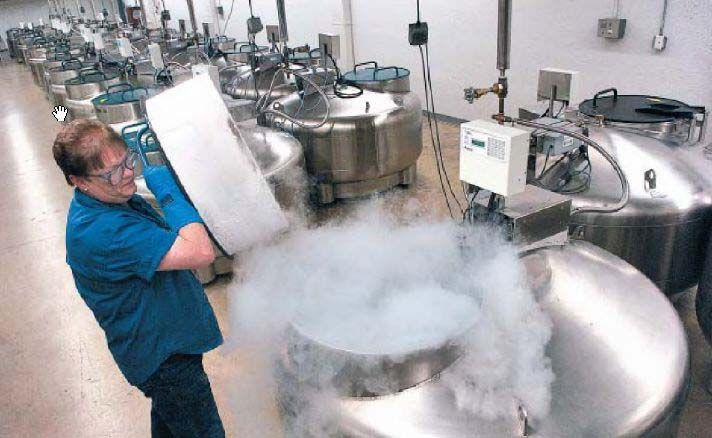| Welcome and Tour |

|
Welcome to the Seed Preservation Programs at NLGRP
|
|
Seed storage at NLGRP is much more than placing bags of seeds in a vault. NLGRP receives samples from a wide range of institutions, companies and governments around the world. Our technicians and specialists work with the database that handles all the information accompanying each sample. We evaluate the initial seed quality, store samples in cold or cryogenic vaults and monitor the quality of stored seeds. Since 1958, we have been storing, maintaining, monitoring and distributing hundreds of thousands of samples trusted to us for the long term backup portion of the National Plant Germplasm System (NPGS).
-
Virtual tour:
-
Who sends samples to NLGRP?
-
How do we take care of them?
-
-
More about our collections:
-
Databases
-
Types of collections
-
-
Other NLGRP seed activities and partnerships:
-
Svalbard
-
SOS
-
Who sends samples to NLGRP?
Our seed samples come from many donors and sources:

NLGRP receives seed materials from all over the United States and the world. NLGRP stores the base collection of the National Plant Germplasm System. NLGRP also works with international organizations such as the International Maize and Wheat Improvement Center (CIMMYT - Mexico), the International Rice Research Institute (IRRI - Philippines) and the International Plant Genetic Resources Institute (Bioversity International - Rome), as well as the Centers for Plant Conservation (CPC), the Crop Science Society of America for Crop Science Registration (CSR), and the Plant Variety Protection Office (PVPO).
Quarantine Seed Quarantine is a government program to monitor and control the importation of plant and animal materials. Samples that arrive at NLGRP under quarantine restrictions are handled in the quarantine laboratory. Samples are inspected and prepared for storage in a laminar flow biological safety cabinet. Material being prepared for increase is surface sterilized and treated with a fungicide prior to shipment. All germplasm is increased and inspected for disease and/or insect infestations by APHIS inspectors on the island of St. Croix (a substation for the Tropical Agriculture Research Station in Mayaguez) or other approved sites prior to release into the National Plant Germplasm System.
How do we take care of the seed samples?
Seed sample handling and processing after arrival:
Come and see how we handle and store the valuable materials when they arrive. Take a look inside the vaults to see both conventional and liquid nitrogen (cryogenic) storage.
-
seed receiving
-
equilibration
-
moisture testing
-
cleaning
-
viability assessment and monitor testing
-
vault storage
-
distribution
Seed Receiving
Upon receipt of seed samples, information is verified with GRIN, NLGRP serial numbers are assigned, germination cards and bar code labels are printed. After unpacking, samples are placed in an equilibration room with 23% relative humidity at 5°C. Samples are equilibrated for a few weeks to achieve the optimum moisture content for storage. Moisture tests are conducted to verify that appropriate seed moisture contents have been reached.
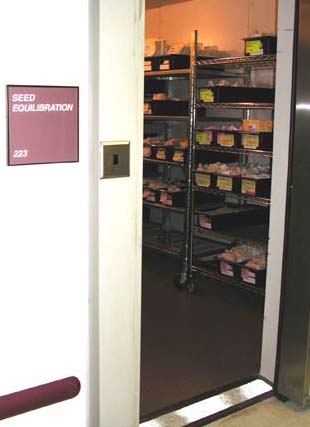 |
 |
Seed equilibration Seed moisture testing
|
|
Viability Assessment
Viability assessment is a means of testing a sample to determine how many seeds are alive and may produce a normal plant. Initial tests are conducted to determine viability before samples are stored. Analysts then may assess viability using germination and tetrazolium tests. Subsequently, samples are tested periodically to monitor seed viability during storage.
|
|
 |
Germination tests
|
Analysts select appropriate conditions and plant a subsample of the pure seed on standard germination blotters or towels. The number of seeds tested is dependent on the size of the sample. All samples scheduled for cryopreservation storage in liquid nitrogen have paired tests performed to check for damage caused by the liquid nitrogen (LN2). |
|
|
|
|
Storage
NLGRP stores samples in conventional storage at -18°C and cryogenic storage using liquid nitrogen at -196°C (-160°C in the vapor phase). Storage method is determined by the type of seed, the size of the seed, the number of seeds in the sample, the viability of the sample, and sometimes the instructions from the donor.
|
Samples stored by conventional methods are transferred to heat sealable, moisture-proof, foil laminated bags. Locations are assigned and barcodes for the location and serial numbers are placed inside and on the outside of the bags. The bags are then heat sealed and placed in trays in the cold storage vault. Samples stored by cryogenic methods are transferred to clear polyolefin tubes, barcoded, and crimped closed. Filled tubes are then placed in metal boxes, labeled with serial numbers and locations, and stored in the LN2 tanks. |
|
Vaults
The vault area at NLGRP is a separately constructed portion of the building, self-contained with its own air handling unit and electrical generator in case of emergency. It is able to withstand possible floods from nearby Horsetooth Reservoir, tornadoes, and the dropping of a 2500 pound object traveling at 125 miles per hour. The vaults have the capacity to store 1.5 million samples, 50% in conventional storage, and 50% in liquid nitrogen.
|
|
Conventional Vault Area |
Cryogenic Vault Area
Two floors of the vault area are designed for cryogenic storage. One is in current use, and the other is designed for expansion. Each floor can hold 112 storage tanks, and has double-walled stainless steel piping for filling from the 13,000 gallon tanks located outside the building.
| Cryotanks are like giant thermos jugs with vacuum jacketed double walled insulation. Each tank will hold 330 metal containers (metal boxes containing tubes of seed samples) on a lazy susan which holds the samples above the liquid nitrogen and allows easy access to each section. A tank holding wheat could contain 2640 samples, whereas a tank of tobacco (a very tiny seed) would contain 26,400 samples. We try to have a minimum of 3000 seeds per sample for cross pollinated crops and 1500 seeds for self-pollinated crops. |
|
Tanks are filled once a week, with about 56 liters of liquid nitrogen.
Air circulation is very important in the vault since nitrogen gas is constantly boiling from the tanks. Oxygen monitors are placed around the vault for detection of oxygen content of the air. Emergency fans are triggered by the oxygen monitors or emergency buttons. During an emergency, liquid nitrogen is shut off and fans provide 14 air exchanges per hour.
All of these elaborate precautions are to ensure that our valuable germplasm lives as long as possible, and is available for plant breeders and researchers to produce the food and fiber products we all depend upon.
Distributions
The NPGS fulfills thousands of requests for its seeds yearly. Seeds are sent to plant breeders and researchers worldwide. The entire National Plant Germplasm System distributes well over 100,000 samples yearly. These go to approximately 70 countries. See our statistics page for more information.
Seed collections database and forms
- GRIN Database: Search the collections of the National Plant Germplasm System using the Germplasm Resources Information Network (GRIN) database.
- Forms for germplasm requests and submissions.
Types of collections in storage
- Base: The National Plant Germplasm System and its components. Seeds of Success program samples are included here.
- Security Back-up and black box collections: Special agreements with a wide range of institutions and groups.
- Journal of Plant Registration: Describes the process for depositing voucher specimens required for The Journal of Plant Registrations and the subsequent release to the National Plant Germplasm System.
- Plant Variety Protection: Describes the process for depositing voucher specimens required for Plant Variety Protection and the subsequent release to the National Plant Germplasm System.
Other NLGRP seed activities and partnerships
- U.S. contributions to the Svalbard Global Seed Vault: Describes U.S. initiatives to send NPGS seed to the Svalbard Global Seed Vault in Norway and provides a yearly update of progress.
http://www.croptrust.org/content/svalbard-global-seed-vault - SOS Seeds of Success (SOS) is a Federal interagency native plant materials development program. It supports and coordinates seed collection from native plant populations in the U. S. for land rehabilitation, restoration and stabilization. NLGRP is partnering with these agencies to store backup samples for the SOS program. These samples are part of the NPGS Base Collection.
http://www.blm.gov/mt/st/en/prog/botany/sos.html




